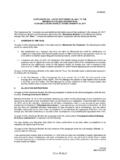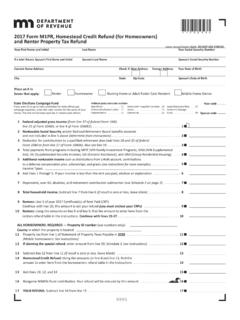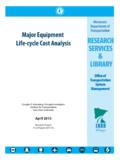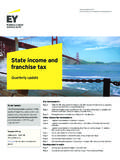Transcription of CITY OF MINNEAPOLIS MINNESOTA MUNICIPAL …
1 CITY OF MINNEAPOLIS , MINNESOTAMUNICIPAL tree RESOURCEANALYSISBYE. GREGORY MCPHERSONJAMES R. SIMPSONPAULA J. PEPERSCOTT E. MACO SHELLEY L. GARDNERSHAUNA K. COZADQINGFU XIAOCENTER FOR URBAN FOREST RESEARCHUSDA FOREST SERVICE, PACIFIC SOUTHWEST RESEARCH STATIONTECHNICAL REPORT TO:RALPH SIEVERT AND JIM HERMANNFORESTRY SECTION, MINNEAPOLIS PARKS AND RECREATION BOARDMINNEAPOLIS, MINNESOTA JUNE 2005 Mission StatementWe conductresearchthat demonstrates new ways in which treesadd valueto your community, converting results into financialtermsto assist you in stimulating more investment in ValueEnergy Conservation Air QualityWater Quality Firewise LandscapesAreas of Research:The United States Department of Agriculture (USDA) prohibits discrimination in all its programs and activities on the basis of race, color, national origin, gender, religion, age, disability,political beliefs, sexual orientation and marital or family status.
2 (Not all prohibited bases apply to all programs.) Persons with disabilities who require alternative means for communicationof program information (Braille, large print, audio-tape, etc.) should contact USDA s TARGET Center at: (202) 720-2600 (voice and TDD). To file a complaint of discrimination, write:USDA Director, Office of Civil Rights, Room 326-W, Whitten Building, 14th and Independent Avenue, SW, Washington, DC 20250-9410, or call: (202) 720-5964 (voice or TDD).USDA is an equal opportunity provider and OF MINNEAPOLIS , MINNESOTAMUNICIPAL tree resource ANALYSISByE. Gregory McPherson1 James R. Simpson1 Paula J. Peper1 Scott E. Maco1 Shelley L. Gardner1 Shauna K. Cozad1 Qingfu Xiao2 June 2005 1 Center for Urban Forest ResearchUSDA Forest Service, Pacifi c Southwest Research Stationc/o Dept. of Plant Science, MS-6 University of CaliforniaOne Shields , CA 95616-85872 Deparment of Land, Air, and Water ResourcesUniversity of CaliforniaDavis, CAAcknowledgementsRalph Sievert, Jim Hermann, Paul Domholt, and Steve Gilbert ( MINNEAPOLIS Parks and Recreation board , Forestry Section) provided valuable information and support for this report.
3 Gail Nozal, Jeanette Monear, Kirk Brown, and Rebekah Van Wieren ( tree Trust) coordinated data collection with trained volunteers. Michael Max (EnvironMentor Systems); Dave Hanson and Gary Johnson (University of MINNESOTA ); David Bloniarz (US Forest Service); and Greg Ina, Jerry Bond, and Jim Jenkins (Davey resource Group) assisted with volunteer training and reference city data col-lection. James Ho and Kelaine Vargas (Forest Service, Center for Urban Forest Research) assisted with data collection and analysis . Mark Buscaino, Phillip Rodbell, Robin Morgan, and Jill Johnson (US Forest Service, State and Private Forestry), and Ken Holman and Don Mueller ( MINNESOTA Department of Natural Resources) provided invaluable sup-port for this project. Thank you modeling and analysis tools used in this study have been subjected to peer-review through the publication process.
4 However, this technical report relies on data obtained from other organizations and it has not been subjected to the full peer-review of ContentsAcknowledgements 2 Executive Summary 5 resource Structure 5 resource Function and Value 5 resource Management Needs 6 Chapter One Introduction 7 Chapter Two MINNEAPOLIS s MUNICIPAL tree resource 8 tree Numbers 8 Species Richness, Composition And Diversity 9 Species Importance 10 Street Trees Per Capita 11 Stocking Level 11 Age Structure 11 tree Condition 12 tree Canopy 12 Location and Landuse 12 Maintenance Needs 12 Confl icts Sidewalk Heaves and Power Lines 13 Chapter Three Costs of Managing MINNEAPOLIS s MUNICIPAL Trees 14 Program Expenditures 14 Costs of Managing Public Trees 14 tree Planting and Establishment 14 Pruning, Removals, and General tree Care 14 Administration 15 External tree -RelatedExpenditures 15 Chapter Four Benefi ts of MINNEAPOLIS s MUNICIPAL Trees 16 Introduction 16 Energy Savings 16 Electricity and Natural Gas Results 17 Atmospheric Carbon Dioxide Reductions 17 Air Quality Improvement 18 Avoided Pollutants 18 Deposition and Interception 18 BVOC Emissions 20 Net Air-Quality Improvement 20 Stormwater-Runoff Reductions 20 Property Valuesand Other Benefi ts 21 Total Annual Net Benefi ts and Benefi t Cost Ratio (BCR)
5 21 Chapter Five Management Implications 24 resource Complexity 24 resource Extent 25 Maintenance 25 Chapter Six Conclusions 26 Appendix A tree Distribution 27 Appendix B Methodology and Procedures 29 Street tree Sampling 29 Population Estimates 29 Growth Modeling 29 Identifying And Calculating Benefi ts 30 Energy Savings 30 Atmospheric Carbon Dioxide Reduction 36 Improving Air Quality 36 Reducing Stormwater Runoff 37 Property Value & Other Benefi ts 37 Estimating Magnitude Of Benefi ts 39 References 425 MINNEAPOLIS , a vibrant city, renowned for its lakes, its livability, and its cultural wealth, maintains trees as an integral component of the urban infrastructure. Research indicates that healthy trees can mitigate impacts associ-ated with the built environment by reducing stormwater runoff, energy consumption, and air pollutants.
6 Trees im-prove urban life, making MINNEAPOLIS a more enjoyable place to live, work, and play, while mitigating the city s environmental impact. Over the years, the MINNEAPOLIS Parks and Recreation board has invested millions in its MUNICIPAL forest. The primary question that this study asks is whether the accrued benefi ts from MINNEAPOLIS s MUNICIPAL forest justify the annual expenditures? This analysis combines results of a citywide inventory with benefi t cost modeling data to produce four types of information:1. tree resource structure (species composition, diver-sity, age distribution, condition, etc.)2. tree resource function (magnitude of environmen-tal and aesthetic benefi ts)3. tree resource value (dollar value of benefi ts realized)4. tree resource management needs (sustainability, maintenance, costs) resource Structure Based on the sample tree inventory, there are 198,633 actively managed street trees in Minne-apolis.
7 Trees are evenly distributed among the three management zones. MINNEAPOLIS streets are nearly fully stocked with trees (87% of possible planting spaces contain trees). There is approximately one tree for every two residents, and these street trees shade approxi-mately 11% of the city. The sample contained 60 tree species with American elm as the dominant tree . Elms account for 10% of all street trees and 28% of all benefi ts. This means that sustaining the high level of benefi ts currently produced by the MUNICIPAL forest depends largely on preserving these elms. Green ash (16% of to-tal benefi ts), littleleaf linden (9%), Norway maple (9%), and sugar maple (8%) are subdominant spe-cies of importance due to their size and numbers. The age structure of MINNEAPOLIS s street trees dif-fers from the ideal in having more maturing trees (6 18 inch DBH) and fewer mature and old trees.
8 As these maturing trees age, the benefi ts they pro-duce will increase. Thus, over the next 50 years, their health and longevity will infl uence the stability and productivity of MINNEAPOLIS s future canopy. Trees are generally in good health (75% good or ex-cellent condition), with approximately 2% in need of removal and 42% needing pruning. Confl icts with power lines are few, but 36% of the sampled trees are associated with sidewalk heaves greater than inch. resource Function and Value Electricity saved annually in MINNEAPOLIS from both shading and climate effects of street trees totals 32,921 MWh, for a retail savings of $ million ($ per tree ). Total annual savings of natural gas total 441,355 MBtu, for a savings of $ mil-lion, or $ per tree . Total annual energy savings are valued at $ million or $ per tree .
9 Citywide, CO2 emission reductions due to energy savings and sequestration by street trees are 27,611 and 29,526 tons, respectively, valued at $857,000 ($ per tree ). Release of CO2 from decomposi-tion and tree -care activities is small (2,012 tons; $30,175). Net CO2 reduction is 55,125 tons, valued at $826,875 or $ per tree . Net air pollutants removed, released, and avoided average 2 lb per tree and are valued at $ mil-lion annually or $ per tree . Avoided emissions of NO2 and SO2 due to energy savings are especial-ly important, totaling about 150 tons and valued at $830,000. Deposition and interception of pollutants by trees totaled 29 tons ($185,585), a small benefi t explained by the region s relatively clean air. The ability of MINNEAPOLIS s MUNICIPAL trees to intercept rain thereby reducing stormwater run-off is substantial, estimated at million cubic feet annually, or $ million.
10 Citywide, the average street tree intercepts 1,685 gallons of stormwater, valued at $ , annually. The estimated annual benefi ts associated with aes-thetics, property value increases, and other less tan-gible benefi ts are approximately $ million or $36 per Summary6 Annual benefi ts total $ million and average $126 per tree . Benefi ts are fairly evenly distrib-uted among the city s three management zones. Stormwater-runoff reduction, energy savings, and aesthetic/other benefi ts each account for nearly one-third of total benefi ts. The tree species provid-ing the greatest percentage of benefi ts are American elms ($354 per tree , 28%), green ash ($137 per tree , 16%), and littleleaf linden ($112 per tree , 9%) be-cause of their size and numbers. Overall, annual benefi ts are determined largely by tree size.








